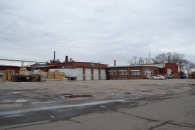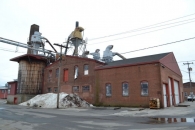Mill Record Enfield
RETURN TO ‘FIND MILLS’Disclaimer: Content for these properties was compiled in 2014-2017 from a variety of sources and is subject to change. Updates are occasionally made under Property Information, however the Connecticut Trust for Historic Preservation (dba Preservation Connecticut) makes no representation or warranty that the information is complete or up-to-date.
- Complex Name (Common)
- Amos D. Bridge’s Sons Inc.
- Complex Name (Historic)
-
- Amos D. Bridge's Sons Inc.
- Address or Location
- 11 Randolph Street, Hazardville, Enfield
- County
- Hartford
- Historic Designation
- Associated Mill Community
- n/a

- Historic Information
Companies Associated w/Complex
- Amos D. Bridge Mfg. Co. ca. 1890-1906
- Amos D. Bridge's Sons, Inc. 1906-1943
- Bridge Mfg. Co., Inc. 1943-1986
- Carris Reels of CT 1986-Present (2015)
Use (Historic)
- Paper & Wood Products
- Other: Paint
Largest Documented Workforce
25-49 (1939)
Historic Narrative
Amos D. Bridge’s Sons, Inc. was originally established as the Amos D. Bridge Manufacturing Company in 1875. The firm was founded by Amos D. Bridge, who had previously been a partner in a bonnet manufactory along with David G., George B., and Andrew Gordon; and Edward Pricket. When changing fashions marked the end of the bonnet industry, Bridge acquired the property and continued to focus on one aspect of the business, the fabrication of wooden shipping boxes. This expanded rapidly along with a litany of Bridge’s other business ventures, including a dairy farm and a local hardware, coal, and wood dealership. Bridge also founded a notable local contracting and road building firm around 1895, as well as chartered the Hazardville Water Company in 1899. Bridge’s box mill was twice destroyed by fire in its early years, in 1883 and 1890. He rebuilt after each setback and by the turn of the century Bridge had expanded his fabrication business to include the manufacture of a variety of wood products. These included tobacco laths and boxes, apple boxes, vegetable crates, racks and pallets used in brickmaking, grain silos, and various types of wire reels. Amos D. Bridge died in 1906, after which the business was incorporated by his five sons, H. Stephen, Allyn G., William A., Homer E., and Charles A., and his nephew, David A. Bridge. The resultant Amos D. Bridge’s Sons, Inc. started with $160,000 of authorized capital and continued to manage the various ventures established by the firm’s namesake. In 1904, H. Stephen Bridge had also partnered with Charles C. Mann, F.A. Pickering, and William H. Whitney Jr. to form the Hazard Lead Works, a paint manufactory that operated in rented buildings within the Bridge Company plant. Whitney had formerly been the superintendent of the King Paint Company and joined his partners in establishing the new paint company. The firm set up equipment for processing and mixing white lead paint, the most notable line of which was a pre-mixed product known as Ironite. The paint was sold at wholesale rates of 60 cents per gallon and retailed for $1. It was available in a variety of colors including red, maroon, brown, green, slate, yellow, and black. The success of the product led to a second factory being established in Brooklyn, New York, in 1907. Amos D. Bridge’s Sons, Inc. continued to thrive up until the early 1930s when the Depression sent some financial tremors through the company. A heavy outlay of credit caused the firm to go into receivership in 1934, however, under careful management the company managed to emerge debt free by 1943. It was at this point in time that the business was divided into various firms, these including the Bridge Manufacturing Company, which continued to fabricate wooden reels and other products; Bridge Construction, which persisted in the road building industry; and the Bridge Insurance Company, a new line of business that had been acquired in 1932. The firms continued to be managed by members of the Bridge family, by this point in its fourth generation of association with the business. The Bridge Manufacturing Company persisted in the production of wood cable reels of all sizes until 1986 when it was acquired by the Carris Reels Company, another manufacturer of wooden reels established in Rutland, Vermont, in 1951. Carris Reels continues to operate the Enfield plant under its Carris Reels of Connecticut division.
- Architectural Information
Number of Existing Buildings
Twenty-two (22) blocks.
Dates of Construction
ca. 1890, ca. 1910s, 1921, mid-late-20th c.
Architect
n/a
Builder
n/a
Building Type
Architectural Description
The former Gordon Brothers Manufacturing Company plant is comprised of two primary clusters of adjoining buildings consisting of upwards of twenty-two (22) identifiable blocks or freestanding buildings located at the northwest corner of the intersection of Randolph Street and Hazard Avenue, and flanking the north and south sides of Oak Street. The manufacturing buildings form the core of the plant and are located directly south of Oak Street. Numerous wood storage and other ancillary buildings are situated throughout the property and date from the mid-to-late 20th c. The storage buildings are generally one- to two-story wood- or metal-frame structures with pitched roofs. The earliest portions of the manufacturing building are located at its northwest corner and were built ca. 1890. These have largely been incorporated into later buildings over the course of the early- to mid-twentieth century, however, the north gable end of one of these buildings is visible from Oak Street. It is a two-story, 44’ x 65’ red brick planing building with segmental-arched window openings (some of these altered and infilled) and a pitched roof. It is flanked by a two-story wooden silo used to collect wood shavings and sawdust. Another early structure rises above the additions that surrounding it showing its stepped brick parapet with a concrete plaque that reads ‘1921’. The two-story block measures 34’ x 78’ and is located southeast of the ca. 1890 block. Later additions that enlarged the plant illustrate the typical construction methods used in the period of their origins, however, most have red brick walls and metal sash of various arrangements.
Exterior Material(s)
Structural System(s)
Roof Form
Roof Material
Power Source
Condition
Fair
Condition Notes
The factory is in overall fair condition. Although sections of the earliest parts of the plant show some staining and deterioration along their exterior walls and are missing many of their original windows, the majority of the plant appears to be structurally sound and well maintained.
- Property Information
-
Specific Location
Two legal parcels (11 Randolph St. and 20 Oak St.) totaling 15.25 acres at the northwest corner of the intersection of Randolph Street and Hazard Avenue, and flanking the north and south sides of Oak Street.
Adjacent To
Exterior Visible from Public Road?
Yes
Parcel ID / Assessor Record Link
Acreage
4.51; 10.74
Use (Present)
- Sources
-
Form Completed By
Lucas A. Karmazinas
Date
03/27/2015
Bibliography
- List of Connecticut Manufacturers, 1922, 1924, 1930, 1932.
- Directory of Connecticut State Manufacturers, 1936, 1939.
- Industrial Directory of Connecticut, 1947.
- Register of War Production Facilities in Connecticut, 1951.
- Map of Hartford County, H & C.T. Smith, 1855.
- Atlas of Hartford County, Beers, Baker & Tilden, 1869.
- Sanborn Map Company, 1947.
- Hartford Courant, 1906, 1930.
- The Challenge of Change: Three Centuries of Enfield, Connecticut History; Bridge, Ruth, ed., 1977.
- Enfield, Connecticut; Miller, Michael K., 1999.
- Representative View(s)Click on image to view full file








